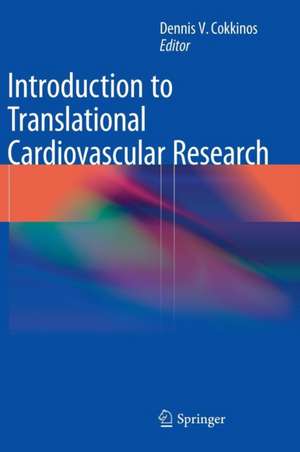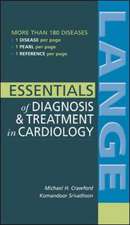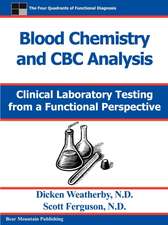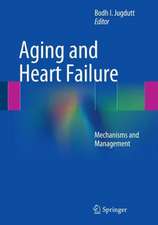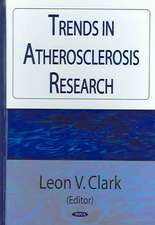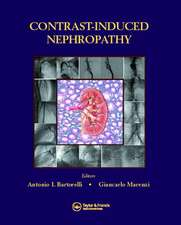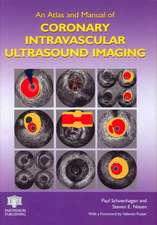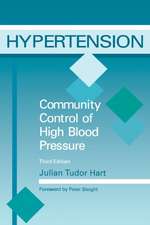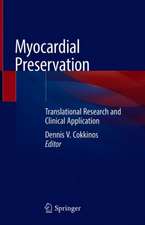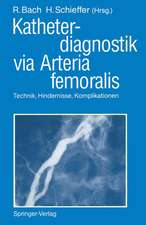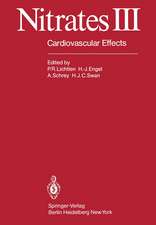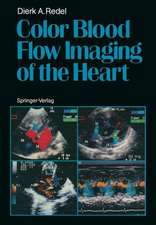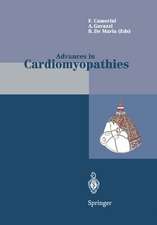Introduction to Translational Cardiovascular Research
Editat de Dennis V. Cokkinosen Limba Engleză Hardback – 19 noi 2014
Introduction to Translational Cardiovascular Research discusses the fundamental and important aspects of the topic. It describes the renin-angiotensin-aldosterone system, the beta adrenergic receptors and the hypothalamic-pituitary-adrenal axis, while covering genetic polymorphisms both generally and specifically as regards the vascular endothelium and the use of microRNAs. As such, this book will be relevant to young physicians, nurses and other scientists engaged in the clinical cardiovascular field who want to added research-oriented dimension to their efforts towards better understanding and practicing of medicine. It also aims to attract young basic researchers who want to develop a better comprehension of the organism as a whole, man or animal, that they are investigating.
Preț: 1130.07 lei
Preț vechi: 1189.55 lei
-5% Nou
Puncte Express: 1695
Preț estimativ în valută:
216.26€ • 234.83$ • 181.66£
216.26€ • 234.83$ • 181.66£
Carte tipărită la comandă
Livrare economică 22 aprilie-06 mai
Preluare comenzi: 021 569.72.76
Specificații
ISBN-13: 9783319087979
ISBN-10: 3319087975
Pagini: 610
Ilustrații: XXI, 610 p. 109 illus., 98 illus. in color.
Dimensiuni: 178 x 254 x 30 mm
Greutate: 1.31 kg
Ediția:2015
Editura: Springer International Publishing
Colecția Springer
Locul publicării:Cham, Switzerland
ISBN-10: 3319087975
Pagini: 610
Ilustrații: XXI, 610 p. 109 illus., 98 illus. in color.
Dimensiuni: 178 x 254 x 30 mm
Greutate: 1.31 kg
Ediția:2015
Editura: Springer International Publishing
Colecția Springer
Locul publicării:Cham, Switzerland
Public țintă
Professional/practitionerCuprins
Introduction – What Is Translational Research.- Insights into heart development and regeneration.- Basis Of Cell Excitability And Cardiac Conduction System.- The Renin-Angiotensin-Aldosterone System In Cardiovascular Diseases.- Beta adrenergic receptors.- The hypothalamic-pituitary-adrenal axis in human health and disease.- Genetic Polymorphisms.- Genetic Polymorphisms and the Vascular Endothelium.- The role of microRNAs in Cardiovascular Disease.- Pathways To Myocardial Hypertrophy.- The multiple actions of the insulin-like growth factor-I signaling in the myocardium.- Calcium Cycling Circuits in Cardiac Physiology and Pathophysiology.- Inflammation and atherosclerosis.- Stress proteins and the Adaptive Response of the Heart.- The Mechanisms And Modalities Of Cell Death.- Repair of the infarcted myocardium.- Pathways to cardiac remodeling.- A Translational Approach to Probe the Arrhythmic Potential of the Heart: Therapeutic Considerations.- Animal Models Of Cardiovascular Disease.- Experimental in vitro assessment of cardiac function.- In vivo experimental assessment of cardiac function.- Non invasive imaging modalities for Cardiovascular Translational Research- Technical Considerations.- Cardiovascular Applications of Non-Invasive Imaging in Cardiovascular Diseases: from Bench to Bedside.- Molecular Imaging of Inflammation Using Echoardiography: Advances With the Use of Microbubbles.- Clinical Aspects And Genetics Of Cardiomyopathies.- Cardiorenal Syndrome: What Basic Research Can Contribute.- Clinical aspects of Cardiorenal Syndrome: consequences of therapy with the Renin-Angiotensin System Inhibitors.- Pre-, Peri-, and Post-Conditioning the ischemic myocardium: Challenges, Confounders and Expectations.- Gene Therapy for the Heart.- Cell therapy in cardiac diseases.- Moving Towards a Novel Paradigm in Drug Development for Worsening Heart Failure: The T1 Model (Mechanistic Translational Phase).
Recenzii
“The book fulfills its purpose of providing a deeper understanding of translational research in cardiovascular diseases. … This will be useful to all in the cardiovascular field, including practicing cardiologists, trainees, researchers, statisticians, internists, nurse practitioners, house staff and the general population. … This is a most comprehensive collection of measures and assessment tools related to translational cardiovascular research. It demonstrates the importance of the application of knowledge acquired from basic research to the practical ends in this area.” (Fahad Javed, Doody's Book Reviews, April, 2015)
Textul de pe ultima copertă
The term “Translational Research” reflects today’s integration of basic research (“bench”) findings with the clinical practice of medicine, and in a wider scope the application of results from the individual patient (“bedside”) to entire populations for the improvement of public health. This book offers future researchers a stimulus in many aspects of cardiovascular research, so as to promote their interest in future fields of cardiovascular disease, diagnosis and treatment.
Introduction to Translational Cardiovascular Research discusses the fundamental and important aspects of the topic. It describes the renin-angiotensin-aldosterone system, the beta adrenergic receptors and the hypothalamic-pituitary-adrenal axis, while covering genetic polymorphisms both generally and specifically as regards the vascular endothelium, and the use of microRNAs. As such, this book will be relevant to young physicians, nurses, and other scientists engaged in the clinical cardiovascular field who want to added research-oriented dimension to their efforts towards better understanding and practicing of medicine. It also aims to attract young basic researchers who want to develop a better comprehension of the organism as a whole, man or animal, that they are investigating.
Introduction to Translational Cardiovascular Research discusses the fundamental and important aspects of the topic. It describes the renin-angiotensin-aldosterone system, the beta adrenergic receptors and the hypothalamic-pituitary-adrenal axis, while covering genetic polymorphisms both generally and specifically as regards the vascular endothelium, and the use of microRNAs. As such, this book will be relevant to young physicians, nurses, and other scientists engaged in the clinical cardiovascular field who want to added research-oriented dimension to their efforts towards better understanding and practicing of medicine. It also aims to attract young basic researchers who want to develop a better comprehension of the organism as a whole, man or animal, that they are investigating.
Caracteristici
Focuses on pathogenetic mechanisms of cardiovascular disease
Provides basic scientific foundation of cardiovascular medicine
Introduces young investigators from clinical and basic research towards a research career
Concentrates on the very rapid evolution of data on these fields
Provides basic scientific foundation of cardiovascular medicine
Introduces young investigators from clinical and basic research towards a research career
Concentrates on the very rapid evolution of data on these fields
